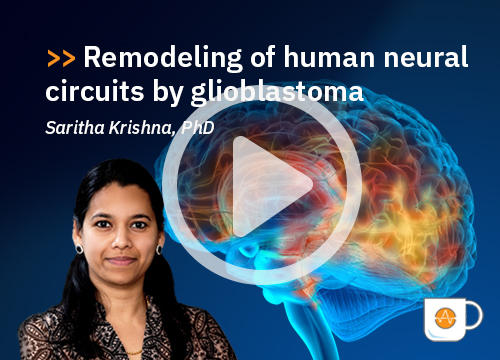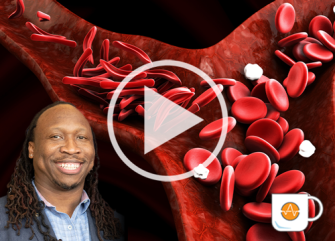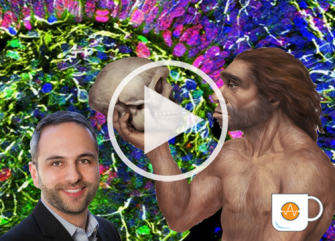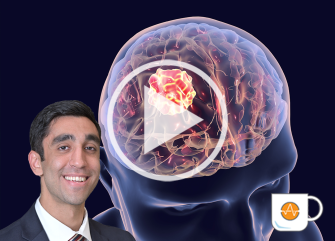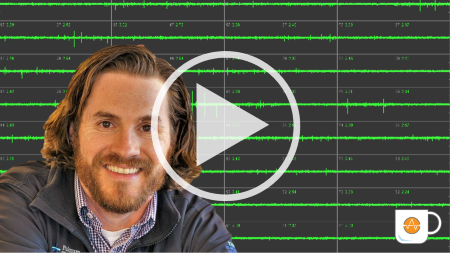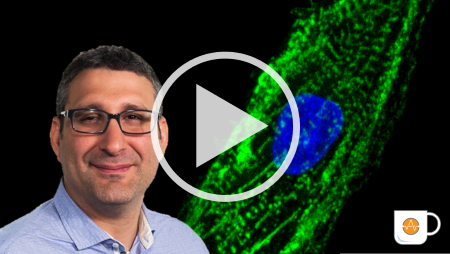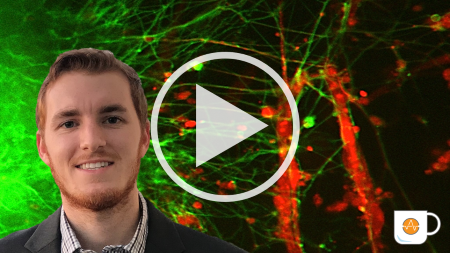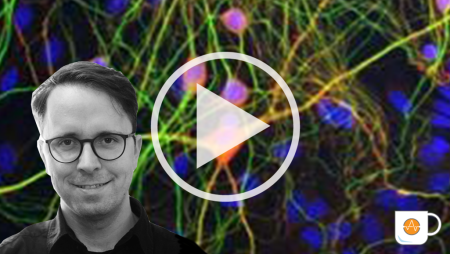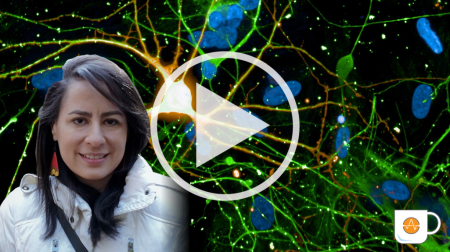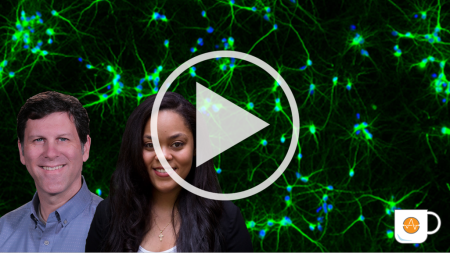In the time it takes to drink your coffee, experts in the field will explain how they are using Axion's technology to empower their research.
Pour yourself a cup of coffee and learn more.

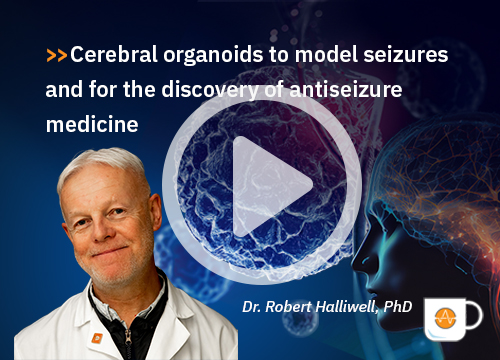
Cerebral organoids to model seizures and for the discovery of antiseizure medicine
In this coffee break webinar, Robert Halliwell (University of the Pacific) discusses how human cerebral organoids—three-dimensional, stem cell–derived models of the brain—can be used to study epilepsy and discover new anti-seizure medicines.

Tracking the translocation of microplastic particles
In this coffee break webinar, Maria Kloukinioti (Maastricht University) discusses how the increasing plastic use is impacting the environment and human health by monitoring translocation of fluorescence-labeled microparticles in real time using the Omni live-cell imaging system.

GF1 rescues proliferation in cells grown in serum-free media
Cultivated meat holds promise for revolutionizing the meat industry but cost and scalability remain significant challenges. In this coffee break webinar, Jenna Al-Saleh (Novel Farms, Inc.) discusses how Novel Farms addresses these challenges by investigating low-cost alternatives to media components using the Maestro Z impedance platform.

Cisplatin resistance in testicular germ cell tumors
Testicular germ cell tumors represent the most common malignancy in men between 20 and 40 years of age. While cisplatin-based chemotherapy has been a highly effective therapeutic approach, about 5-15% of patients develop recurrent chemo-resistant malignancies. In this webinar, Dr. Lucia Kusarova (Comenius University Medical Faculty and Cancer Research Institute of Biomedical Research Center, Bratislava) discusses her translational research for identifying novel combination treatments for cisplatin-resistant testicular germ cell tumors.
Remodeling of human neural circuits by glioblastoma
Brain tumors are known to infiltrate healthy brain tissue and alter function. In glioblastoma, the most fatal type of adult brain tumor, this functional decline is particularly devastating. In this coffee break webinar, Dr. Saritha Krishna (University of California, San Francisco) applies the principles of glial-neuron communication to brain tumors and studies the mechanisms by which gliomas interface with the neuronal microenvironment and affect functional cognitive networks.
Making models of the peripheral nervous system
Peripheral neuropathies have been difficult to model in vitro due to the inaccessibility of appropriate human models. In this webinar, Dr. Nadja Zeltner and Dr. Vicente Kenyi Saito-Diaz (University of Georgia) discuss how their lab developed a protocol to derive enriched populations of peripheral neuronal subtypes which they characterized using the Maestro multielectrode array assay.
Sickle Cell Anemia and Vascular Permeability
In a patient with Sickle Cell Anemia, you can have altered endothelial cell permeability due to the chronic inflammation of the cells that line the blood vessel wall and control transportation. In this webinar, Manu Platt, PhD (Georgia Institute of Technology) discusses how he evaluated the difference in vascular wall permeability in control and sickle cell disease models as recorded on the Maestro live-cell analysis system.
Neanderthal Mini-Brains
The genomes of Neanderthals and modern humans are very similar. By investigating the differences in genetic make-up, we can gain insights into what separated modern humans from our extinct relatives. In this webinar, Cleber Trujillo, PhD (StemoniX) discusses how he introduced an archaic variant gene, NOVA1, into human pluripotent stem cell-derived brain organoids and evaluated the impact on neural activity as recorded on the Maestro MEA system.
Brain tumors that cause epilepsy
Glioma is one of the most common forms of brain tumor. Up to 70% of patients with glioma experience seizures which negatively impact their quality of life. Unfortunately, 40% of these patients don’t respond to anti-epileptic drugs, meaning a better understanding of the biological mechanism is required to produce more targeted therapies. In this webinar, Armin Mortazavi (National Institute of Health) discusses how he used a transwell glial cell-cortical neuronal co-culture model to study the impact of tumor metabolites on neural activity as recorded on the Maestro MEA system.
Zebrafish EEG in a dish
Zebrafish are used extensively in disease modeling and drug development due to their high level of genetic conservation, associated disease phenotypes, and ability to rapidly reproduce. Though it is a useful model for neural development and neurological disease, achieving high quality electrophysiological readings from live zebrafish can still be a challenge. In this webinar, Dr. Danielle Tomasello (Whitehead Institute for Biomedical Research), describes an easy-to-use method to measure neural activity in living zebrafish larvae using microelectrode arrays, or MEAs, and demonstrates it by measuring responses to valproic acid in the brain and spinal cord.
Neural organoid activity mimics the fetal brain
Understanding the developing brain is challenging due to the absence of good test model. Neural organoids, also known as mini brains, have emerged as a promising new model for studying the human brain. A neural organoid is a three-dimensional human stem cell-derived in vitro culture system that can be studied in a dish. After 40 days in culture, the hiPSC-derived neurons in the neural organoid develop complex neuronal network activity that mimics that found in the fetal brain. In this webinar, Dr. Patapia Zafeiriou (University Medical Center Goettingen) discusses how her lab used a Maestro multielectrode array assay to record the complex neural network activity from Bioengineered Neural Organoids (BENOs).
Race to find COVID-19 Therapy
Severe acute respiratory syndrome coronavirus 2 (SARS-CoV-2) is the strain of coronavirus that causes COVID-19, the respiratory illness responsible for the COVID-19 pandemic. With over 22 million confirmed cases worldwide, and 750 thousand deaths attributed to the virus, antiviral therapies against SAR-CoV-2 are urgently needed. Compounds targeting cellular membrane biology and lipid biosynthetic pathways have previously shown promise as antivirals, and are actively being pursued as treatments for other conditions. In this webinar, Prof. Christopher F. Basler (Georgia State University), identifies two small molecule inhibitors of VPS34, an enzyme involved in cell membrane dynamics, as well as two inhibitors of lipid metabolism, that can suppress SARS-CoV-2 virus replication in human cells in vitro.
Plant-derived pectin as breast cancer therapy
Breast cancer is the leading cause of cancer death in women. For breast cancer patients, metastasis, or the spreading of tumor cells to other parts of the body, largely contributes to patient deaths. Modified citrus pectin (MCP) obtained from the peel and pulp of citrus fruits has emerged as a promising anti-metastasis therapy. However, the efficacy of MCP for treating breast cancer cells of varying subtype needs to be better characterized. In this webinar, Dr. Cheryl Gomillion (University of Georgia) discusses how her lab used an impedance-based assay to evaluate the effects of MCP on cell migration through real-time, quantitative monitoring of cell impedance.
Characterizing multivariant neuroactivity patters of environmental compounds
In our daily lives we are increasingly exposed to man-made chemicals, including pharmaceutical compounds, antimicrobials, flame retardants, food-additives, and pesticides. It is well known that nervous system function is particularly sensitive to disruption by a wide variety of compounds. Consequently, approaches to assess neurotoxicity in a high-throughput screen are required. However, neuroactivity is a complex health endpoint, and existing assays don’t cover the breadth of potential neurotoxicity-related targets. In this webinar, Dr. Marissa Kosnik (Stockholm University) in collaboration with US Environmental Protection Agency, demonstrates how measuring compound-induced changes to the spontaneous firing activity of neural cells in an MEA assay can efficiently screen for diverse chemical activities relevant to neurotoxicity, and that chemical structure may be predictive of response patterns.
Targeting glioblastoma: assessing the potency of T cells to kill cancer
Glioblastoma is a particularly aggressive form of brain cancer, and has no effective treatments. Consequently, new therapeutic approaches, such as immunotherapies, are urgently needed to improve patient outcomes. One such therapy is chimeric antigen receptor (CAR) T cell therapy, a form of targeted immunotherapy that involves the modification of a patient’s own T cells to target specific antigens expressed on the tumor cell surface. In this webinar, Dr. Lohitash Karumbaiah and Meghan Logun (University of Georgia) use label-free impedance measurements to assess the targeting potency of activated human T cells on glioma cell monolayers in real-time, and they demonstrate the value of using an in vitro impedance-based assay to access therapeutic CAR T-cell potency against glioblastoma.
Measuring oscillatory waves in cerebral organoids
The development of disorders such as autism and schizophrenia are thought to have their origins in the developing brain. But studying the development of the human brain is challenging due to the absence of good model. In this webinar, Prof. Alysson Muotri (UC San Diego) demonstrates that the spontaneous development of neural networks in neural organoids, commonly referred to as “mini-brains,” resembles those found during early human brain formation. The research findings covered in this webinar were published recently in the journal Cell Stem Cell, and were featured in numerous media outlets including the New York Times and NPR.
Modeling pediatric epilepsy with iPSC-based technologies
Epilepsy is a devastating neurological disease caused by an imbalance in the electrical signals between the cells of the brain. It affects 1% of newborns and very young children. In children, 1/3 of all cases fail to respond to currently available medication. The primary challenge in the fight against epilepsy is the lack of model systems that effectively mirror what goes wrong in human patients. In this webinar, Dr. Evangelos Kiskinis (Northwestern University), demonstrates how patient-specific neurons in vitro recapitulate the neural firing patterns observed in patient EEGs in vivo. Using this platform Dr. Kiskinis hopes to be able to predict what drug would work best for each patient, removing the trial-and-error approach to epilepsy therapy.
Restoring Fragile X function with gene editing
Fragile X syndrome is the most prevalent genetic form of intellectual disability. There is no cure or treatment due in part to the complexity in the Fragile X syndrome neuronal circuitry. In this webinar, Dr. John Graef (Fulcrum Therapeutics) demonstrates how Fulcrum can create the Fragile X syndrome phenotype in a dish using CRISPR gene-editing and patient-derived cells.
Long QT Syndrome
Long QT syndrome, also referred to as LQTS, is a genetic disorder which affects the repolarization of the heart after a heartbeat. This prolonged repolarization of the heart is observed as a lengthening of the QT interval in the electrocardiogram, hence the disorders name. A long QT interval can upset the careful timing of the heartbeat and trigger dangerous heart rhythms which can result in fainting, seizures, or sudden death. In this webinar, Dr. Vincenzo Macri (STEMCELL Technologies) discusses how the stem cell culture and gene editing technologies being developed by his lab can be used to recreate these patient heart beats in a dish.
Neuromuscular disorders: Controlling contractions with light
Neuromuscular disorders include ALS, myasthenia gravis, and the muscular dystrophies such as Duchenne's. Collectively these disorders exceed an incidence of 1 in 3,000. Although there is a strong genetic understanding of many of these disorders, the poor translatability of animal models to humans has hindered the development of treatments for these diseases. Consequently, there is a need for a model that more faithfully recapitulates the physiology of the human neuromuscular junction. In this webinar, Dr. Elliot Swartz (UCLA) discusses how he is building a light controlled hiPSC model of a neuromuscular junction to help better understand neuromuscular disorders.
The spectrum in a dish: using neurophysiology to build an iPSC-model of autism
Autism, also known as autism spectrum disorder, is a range of conditions classified as neurodevelopmental disorders. Individuals diagnosed with autism show challenges with social skills, repetitive behaviors, speech and nonverbal communication. Autism is estimated to affect about 1% of people, or 62.2 million globally. The genetics of autism are complex meaning better methods are required to help understand the genetic risk factors that underlie autism. In this webinar, Dr. Michael Nestor (The Hussman Institute for Autism) discusses how studying the spontaneous firing activity of patient-derived iPSC neurons in an MEA assay is helping to build a model of autism.
Seizure Prediction using AI
Neurotoxicity is a leading cause of pharmaceutical compound attrition. Drug-induced seizures can deprive the brain of oxygen resulting in brain injury and an increased incidence of mortality. These seizures are the result of excessive and synchronous firing of cortical neurons in the brain. Microelectrode array assays have emerged as a promising tool to predict seizure risk by measuring drug-induced changes to the spontaneous firing activity of neural networks in vitro. In this webinar, Dr. Benjamin Bader (NeuroProof) discusses how artificial intelligence-based machine-learning can be applied to these neural MEA datasets to improve the prediction of seizure risk.
Screening for environmental toxins with human brain in a dish model
In our daily lives we are exposed to thousands of commercially used chemicals. Many of these chemicals are not toxic at typical exposure levels, but for thousands of chemicals, toxicological information is lacking. The National Academy of Sciences report on ‘‘Toxicity testing in the 21st century’’ highlighted the need for efficient methods to screen chemicals (e.g. insecticides) for their potential to cause toxicity. In this webinar, Dr. Lorena Saavedra (NeuCyte) discusses how measuring compound-induced changes to the spontaneous firing activity of human stem cell-derived neural cells in an MEA assay helped detect potentially harmful neurological side effects of compounds such as pyrethroid insecticides.
Curing the pain of burning man
“Man on Fire” syndrome, also known as Inherited Erythromelalgia (IEM), is a chronic pain syndrome characterized by burning pain in the hands and feet. The chronic pain of most patients with IEM cannot be relieved by common pain killers making this disease a major unmet medical need. In this webinar, Dr. Yang Yang (Purdue University) discusses advances in the treatment of IEM using a pharmacogenomic approach. The drug responsiveness of different genetic mutations associated with IEM were probed in an in vitro Maestro MEA assay, with the results helping to predict the effective treatment of these IEM patients in the clinic.
Don't miss a beat with LEAP: An advanced arrhythmia assay (CiPA)
The inability to predict a drug’s cardiovascular liability prior to clinical trials or launch has resulted in numerous costly late stage drug development failures and market withdrawals. The aim of the Comprehensive in vitro Proarrhythmia Assay (CiPA) initiative is to update the existing cardiac safety testing paradigm to better evaluate arrhythmia risk. One proposed test of the CiPA panel is a microelectrode array (MEA) assay that tracks drug-induced changes to beating heart cells in a dish. In this webinar, Dr. Daniel Millard, discusses advances in arrhythmia detection to support next-generation CM-MEA assays.
Modeling epilepsy
Sixty-five million people world-wide suffer from epilepsy. Epilepsy is characterized by seizures, which are the result of excessive nerve activity in the brain. While treatments are available, finding the optimal medication for any patient involves a period of trial-and-error. The need to better understand the underlying causes and develop better treatments for epilepsy are clear. In this webinar, Dr. Mike Boland and Dr. K. Melodi McSweeney (Columbia University) discuss the power of utilizing genetically engineered mice to explore the neuronal networks associated with epilepsy.
